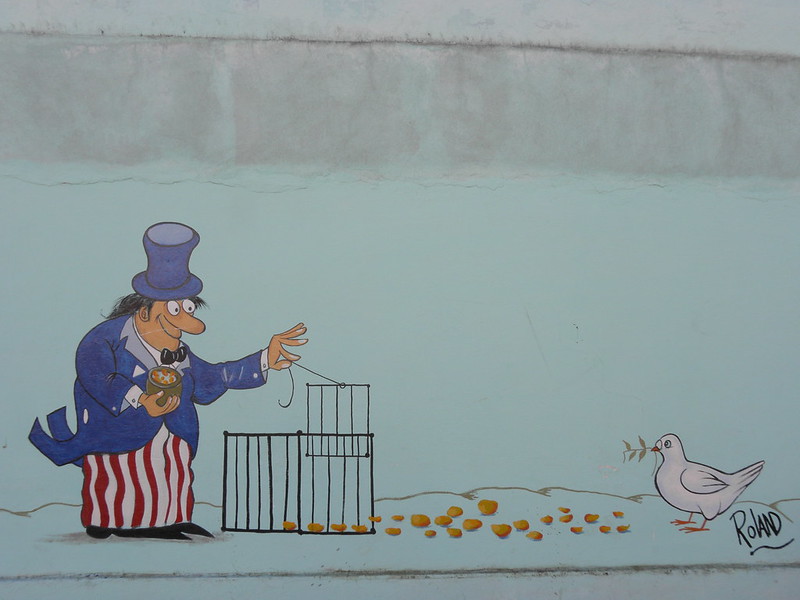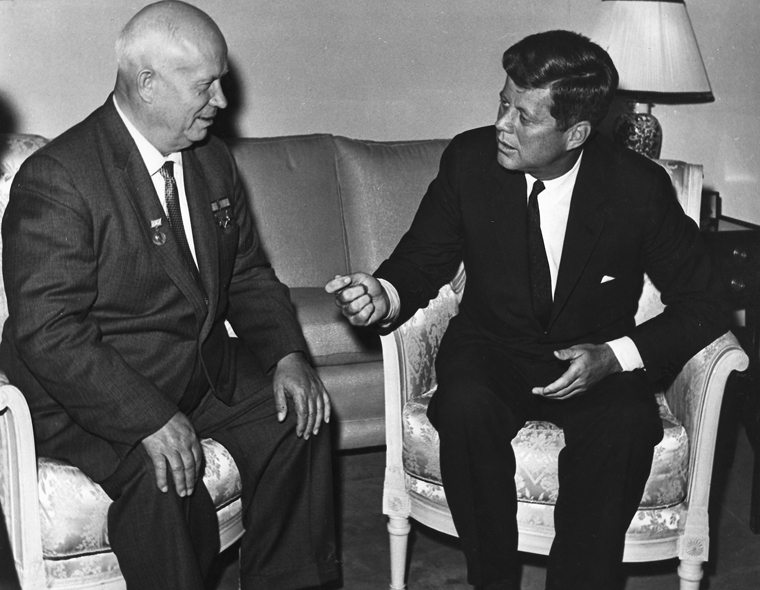Blog Connections
Cold War
This week it has been reported that Ukraine plans to fast track Chernobyl for WH status. For someone my age it brings back memories from the Cold War, with news about the nuclear disaster seeping slowly through the Iron Curtain in 1986. In the WH nomination pipeline also are Gdansk Shipyard (in the TWHS description referred to as symbolizing “the end of the Cold War”) and the Korean DMZ (“the DMZ is a symbolic space of the inter-Korean cold war” (source)). Post-War era and Cold War sites were considered underrepresented in the ICOMOS Filling the gaps analysis from 2004, so we can expect more of them to come.

The Cold War “was a period of geopolitical tension between the Soviet Union and the United States and their respective allies, the Eastern Bloc and the Western Bloc, after World War II. … the period is generally considered to span the 1947 Truman Doctrine to the 1991 dissolution of the Soviet Union” (wiki). Related WHS which we grouped into a connection include venues where summits between the parties were organized, nuclear testing sites and strategic military locations. These links are mostly by coincidence, so far there is only one site where the Cold War is part of the OUV.
Politics
It may all have started at what later became the Potsdam WHS: the Cecilienhof Palace was the venue for the Potsdam Conference of 1945, where the USSR, the USA and the UK had gathered on how to administer Germany. Expansion of communism and nuclear power were important topics too.
In 1961 the Vienna Summit, where they mainly discussed the Berlin Crisis, was held between Kennedy and Chrushchov. Both leaders stayed at Hotel Imperial at the Ring in Vienna. The opening dinner was held at Schönbrunn Palace.
Throughout the whole period, the Kremlin was the seat of the communist Russian government and the Red Square saw many Soviet Union parades “for May Day (until 1969), Victory Day, and October Revolution Day, which consisted of propaganda, flags, labor demonstration, marching troops, and showing off of tanks and missiles”. The Kremlin was also the venue for the Moscow Summits of 1972 and 1974 (Nixon – Brezhnev) and 1988 (Reagan – Gorbachev).

Implications on a global scale
The Cold War had a lot of impact outside of the USA & USSR: the unfortunate inhabitants of the Bikini Atoll in the Pacific were removed from their ancestral lands to allow for nuclear testing in the area. This is the only WHS so far with Cold War in its OUV: “birth of the Cold War … race to develop increasingly powerful nuclear weapons …. escalation of military power which characterized the Cold War”.
Cuba’s Desembarco del Granma park “includes the nationally important site of Fidel Castro’s “desembarco” in 1956 where he and a group of 82 revolutionaries landed after sailing from Mexico” - this was highlighted in the IUCN evaluation. During the Cold War, Castro aligned with the Soviet Union and allowed the Soviets to place nuclear weapons in Cuba, resulting in the Cuban Missile Crisis – a defining incident of the Cold War – in 1962.

Paranoia
Fortress Stevnsfort at Stevns Klint was part of the Baltic Sea defense of Denmark and NATO. It contains 1.8 kilometres of underground passageways carved out of Stevns Klint. Because it was hidden away behind solid layers of chalk, Stevnsfort could withstand a direct attack by a nuclear bomb.
The weirdest connection between WHS and the Cold War must be Fujian Tulou. I’ve tried to find the origins of this apocryphal story – which certainly does not feature in the Chinese nomination dossier. I found this in the Beijing review (2011): “One day, a U.S. satellite suddenly discovered several buildings which looked like nuclear missile silos in the mountains of Fujian Province. American military officers at the U.S. Embassy in Beijing were reportedly immediately dispatched to Yongding County in Fujian, where they discovered that the "silos" were nothing more than Tulou. As a result, Fujian Tulou was unveiled to the world.”
Els - 20 December 2020
Comments
Durian 25 December 2020
For SE Asia, Cold War was about proxy wars. We faced many less known conflicts in Indochina. But for WHS, I think the most unique maybe the Plain of Jars in Laos and its all those tragic aerial bombs by American, the bombardment of historical Hue and ancient My Son during Vietnam War.
Colvin 22 December 2020
I'd love to see what Germany might put forward to fill in a Cold War gap. I've expressed before how I think the Berlin Wall is a very tangible piece of Cold War history, and I'm glad parts of it are preserved in situ.
Another link to the Cold War came to mind in regard to East Asia. The Great Wall and the Forbidden City (see the Nixon Foundation records) were both visited by US President Nixon in 1972 during his landmark trip to China, in which the US restored relations with Communist China after years of disengagement. Nixon's unexpected overture to China during the Cold War opened up China to the West, and drove a wedge into Sino-Soviet relations.
Nan 21 December 2020
If Cold War is a gap, then Germany will have to revise it's list yet again.
1) While the Wall is mostly gone, several bits remain in Berlin and along the East/West Border.
2) Berlin obviously has several key parts: Checkpoint Charlie, Glienicker Brücke, Tempelhof Airport.
3) The open border in Hungary would probably have to feature somehow, too.
Colvin 21 December 2020
There's one other tenuous connection to World Heritage Sites and the Cold War that comes to mind:
Egyptian President Nasser used Cold War enmity to play the US and the USSR off each other and ultimately secure Soviet funding for Egypt's desired Aswan High Dam on the Nile in 1956. As a result of the dam's construction, UNESCO initiated its Nubia campaign in 1959 in order to save the Nubian Monuments from Abu Simbel to Philae from the rising waters of Lake Nasser. The rest is World Heritage Site history.
Colvin 21 December 2020
Interesting observation about the spas in Eastern Europe; it makes sense that they would have been opened to the people.
Another site that can be linked to the Cold War would be Papahânaumokuâkea. Midway Atoll was the site of a US naval facility that tracked Soviet submarines during the Cold War.
Matejicek 20 December 2020
As I grew up on the other side of the curtain, I remember also other aspects of Cold War that were somehow beneficial (but these benefits were fed up mostly by propaganda and were rather unreal): one example is TWHS Mountain-top Hotel and television Transmitter Ještěd as an example that "we" were technologically and economically at least at the same level as western capitalistic world. The second example of weird propaganda can be found in TWHSs Great Spas of Europe (Czechia), where spa guests and clientele of luxury spa hotels had totally changed in 50s and 60s, and decadent egoistic capitalists were replaced by working class and poor peasants.
Els Slots 20 December 2020
Good additions, thanks Colvin!
Colvin 20 December 2020
There are some other historical connections to the Cold War in Eastern Europe as well:
Budapest saw students marching to the Parliament Building to protest the Communist regime during the Hungarian Uprising of 1956. This uprising was quickly quelled, and Soviet tanks entered Budapest, protecting the Parliament Building and other key sites.
Prague had its own challenges in 1968, when Warsaw Pact forces took over the city and country to stifle "Prague Spring". This led to widespread protests, including the self-immolation of students Jan Palach and Jan Zajic in Wenceslas Square, in protest of the Warsaw Pact's military occupation of Czechoslovakia. A memorial to the students can be found in the square.
Colvin 20 December 2020
One could make the case that the Space Race was a beneficial result of the Cold War. Accordingly, the Jodrell Bank Observatory played a role in the Cold War through tracking Sputnik 1, and later tracking early spacecraft from the US and the USSR.